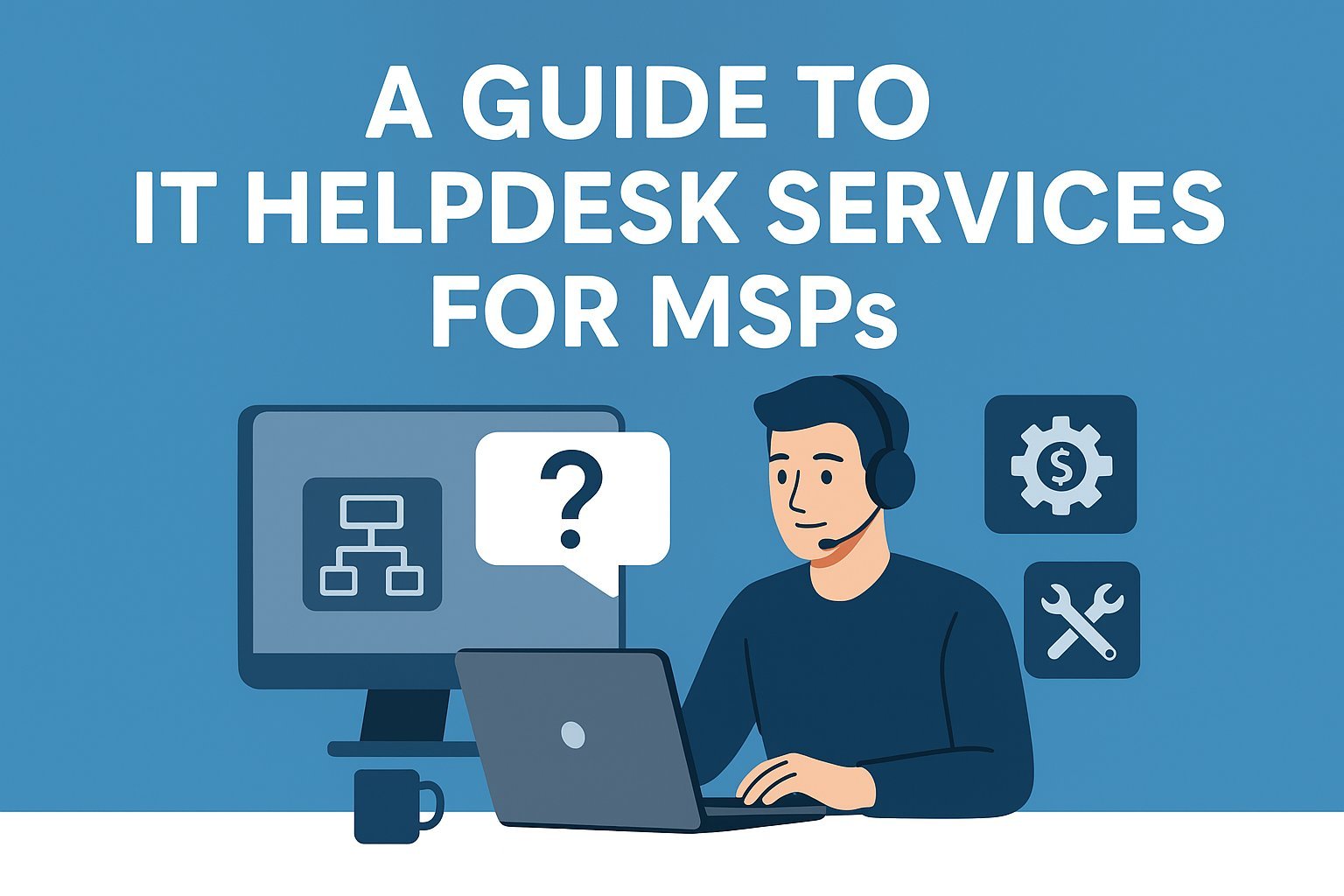The traditional model of IT support is dying. MSPs that still rely on on-site visits are watching competitors win contracts. Remote IT helpdesk services deliver:
- Faster problem resolution
- Lower costs
- Instant access from anywhere
Modern businesses demand immediate technical support. They don’t care about location or time zone. Remote IT helpdesk services answer this demand using advanced tools and secure connections.
The Remote IT Helpdesk Services Revolution
Remote IT helpdesk services changed everything. They shifted support from reactive visits to instant technical help. This affects how MSPs operate and serve clients.
1: Instant Problem Diagnosis Capabilities
Remote IT helpdesk services use smart diagnostic tools. These tools identify issues within minutes, not hours.
Key advantages include:
- Screen-sharing shows exactly what customers see
- No more guesswork from phone calls
- Instant access to system information
Advanced monitoring systems work 24/7. They track network performance and server health across client environments. Remote IT helpdesk services often detect problems before customers notice them.
Remote technicians can:
- Access system logs immediately
- Run performance tests in real-time
- Analyze configuration settings quickly
- Find root causes accurately
2: Geographic and Time Zone Advantages
Remote IT helpdesk services remove location barriers. One team can serve clients across multiple states or countries. No travel expenses. No scheduling headaches.
Time zones become an advantage:
- 24/7 support through global teams
- Someone always available for problems
- Consistent service quality everywhere
Multi-location businesses love this model. They don’t need on-site technicians in every office. Expert IT helpdesk services work from anywhere with the same quality.
You can find more in-depth technical discussions like this in the Zynrewards technichal blogs as well.
Cost Analysis: Remote vs. On-Site Support Economics
Money talks. Remote IT helpdesk services save serious cash compared to on-site visits.
1: Direct Cost Comparisons
On-site visits cost $150-$300 per trip. This includes:
- Technician time
- Travel expenses
- Lost opportunity costs
Remote IT helpdesk services handle the same issues for $50-$100. That’s 60-70% savings per incident.
Real numbers matter:
- Mid-sized MSP: 200 incidents monthly
- Annual savings: $20,000-$40,000
- Just from switching appropriate issues to remote
Travel time costs more than people think. On-site visits need 2-4 hours total including travel. Remote IT helpdesk services resolve similar issues in 30-60 minutes.
2: Scalability and Resource Efficiency
Remote IT helpdesk services scale better than on-site teams.
Growth advantages:
- No need to hire local technicians
- Instant coverage expansion
- Flexible resource allocation
Technicians handle multiple clients simultaneously. Smart queue management and priority routing make this possible.
Peak demand periods don’t require extra staff. Remote IT helpdesk services redistribute workload across available technicians. Location doesn’t matter.
Technology Requirements and Security Considerations
Good remote IT helpdesk services need solid technology and tight security.
1: Essential Technology Stack
Remote access tools form the foundation:
- TeamViewer for general remote access
- ConnectWise Control for MSP integration
- Microsoft Remote Desktop for Windows environments
Cloud-based ticketing systems enable remote work. Technicians access customer information from anywhere. Integration with existing MSP tools keeps workflows smooth.
Communication platforms support:
- Voice calls for real-time discussion
- Video for complex explanations
- Chat for quick updates
- Session recording for training
2: Security Protocols and Best Practices
Remote IT helpdesk services must protect customer data. Security measures include:
Access Controls:
- Multi-factor authentication
- Encrypted connections
- Session monitoring
- Limited system access
Time Management:
- Temporary access tokens
- Automatic session expiration
- Specific time windows for access
Regular security audits ensure compliance. All remote sessions need documentation for audit trails.
Customer Acceptance and Implementation Strategies
Customers sometimes resist remote support. They prefer seeing technicians work on-site. Smart implementation overcomes this resistance.
1: Building Customer Trust
Remote IT helpdesk services must prove their value:
Transparency Methods:
- Explain each diagnostic step
- Show problem-solving process
- Share screen during work
- Provide clear communication
Success Metrics:
- Faster resolution times
- Higher first-call resolution rates
- Better customer satisfaction scores
- Measurable cost savings
These numbers build confidence in remote capabilities.
2: Hybrid Support Models
Smart MSPs combine remote IT helpdesk services with strategic on-site visits:
Remote-First Approach:
- Handle initial troubleshooting remotely
- Escalate to on-site only when necessary
- Reduce on-site visits by 70-80%
- Improve overall response times
On-Site Requirements:
- Critical infrastructure failures
- Security breach responses
- Hardware replacements
- Complex installations
This hybrid model maximizes efficiency while keeping customers comfortable.
Performance Metrics and Quality Assurance
Measuring remote IT helpdesk services requires specific metrics.
1: Key Performance Indicators
First-Contact Resolution:
- Target: Above 75% for remote issues
- Shows effective remote capabilities
- Indicates proper technician training
Resolution Speed:
- Remote should beat on-site for software issues
- Typical improvement: 60-80% faster
- Track by issue type for accuracy
Customer Satisfaction:
- Compare remote vs. on-site experiences
- Regular surveys show acceptance levels
- Identify improvement opportunities
2: Continuous Improvement Processes
Remote IT helpdesk services improve through:
Performance Reviews:
- Identify common issues
- Share successful strategies
- Find training opportunities
- Use session recordings for coaching
Knowledge Base Development:
- Document common problems
- Record proven remote solutions
- Enable faster resolution times
- Ensure consistent service quality
Technology Updates:
- Evaluate remote access platforms regularly
- Upgrade diagnostic tools when needed
- Test new communication systems
- Maintain competitive advantages
Future Trends and Opportunities
Remote IT helpdesk services keep evolving with new technology.
1: Emerging Technologies
Artificial Intelligence:
- Automatic problem identification
- Predictive issue prevention
- Smart diagnostic recommendations
- Reduced human intervention needs
Augmented Reality:
- Visual step-by-step guidance
- Remote technicians guide customers
- Bridge gap between remote and hands-on
- Complex procedure assistance
Internet of Things:
- Unprecedented device visibility
- Granular performance monitoring
- Proactive maintenance capabilities
- Failure pattern recognition
2: Market Evolution
Customer expectations drive change:
- Instant problem resolution demands
- Location-independent support needs
- Cost pressure on all industries
- Regulatory compliance accommodation
Remote IT helpdesk services meet these evolving demands better than traditional models.
Making the Strategic Transition
The shift to remote IT helpdesk services isn’t just inevitable—it’s already happening. MSPs face a clear choice: lead this transformation or watch competitors capture market share.
The Business Case is Clear:
- 60-80% faster resolution for software issues
- 60-70% cost savings per incident
- Instant geographic expansion capability
- 24/7 support coverage without local hiring
Success Requires Strategic Investment:
- Technology: Robust remote platforms and security
- Training: Comprehensive remote support programs
- Process: Gradual transition with hybrid flexibility
Customer expectations have permanently shifted toward instant, location-independent support. Remote IT helpdesk services deliver on these expectations while traditional models struggle with cost and accessibility limits.
Your Next Move
The market has already decided the winner. Remote IT helpdesk services dominate because they solve real business problems that on-site models cannot address effectively.
Smart MSPs are building remote capabilities now while competitors debate whether change is necessary. The accessibility revolution defines competitive survival in modern IT services.
The question isn’t whether remote IT helpdesk services will dominate—it’s whether your MSP will be ready when they do.



Leave a Reply